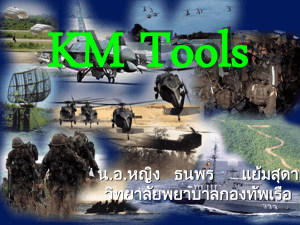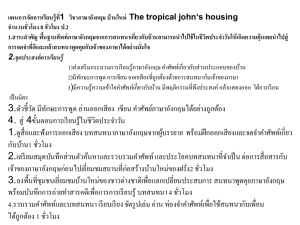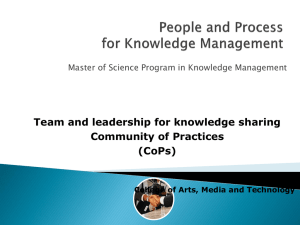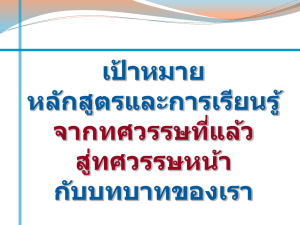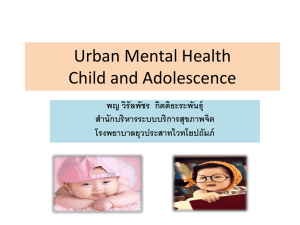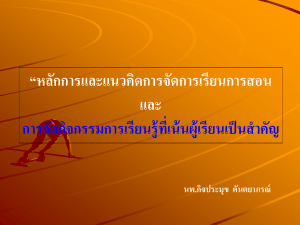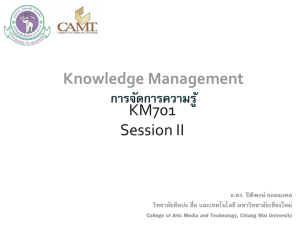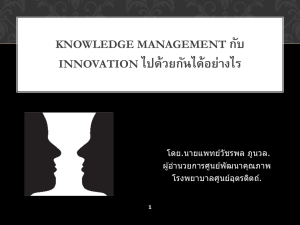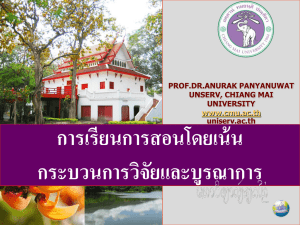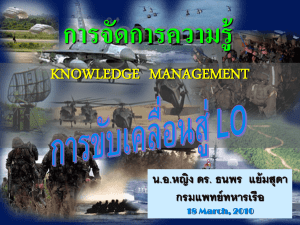Strategic Implementation
advertisement
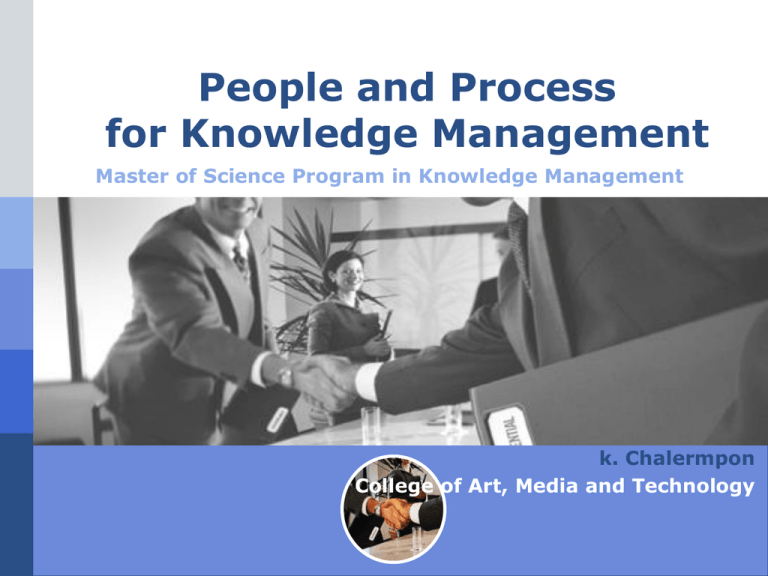
People and Process for Knowledge Management Master of Science Program in Knowledge Management k. Chalermpon College of Art, Media and Technology LOGO Study Plan Part I Introduction and Concept Introduction to knowledge’s Concept Being a Learning Organization Learning Process and Learning Culture Part II Tools and Strategies Creation of learning climate and its components Organizational infrastructure design Connecting people to people Tools and strategies of solving learning problems Team and leadership for knowledge sharing Community of Practice (CoP) Problem solving and creative thinking IT in human systems; systems assessment Learning System Assessment CAMT Intro to People & Process for KM People – ORG -Stakeholder -Share Holder -Staff -Customer -Role – Drive ORG – Practice & Learning -Standard (Process) -Practice วัตถุประสงค์ โครงสร้าง ภายใน กลไกการทางาน CAMT Intro to People & Process for KM Process -Core/Support โครงสร้าง ภายใน วัตถุประสงค์ Map – Strategy -Financial -Productivity & growth -Customer -Product&Service/relationship/imageกลไกการทางาน -Internal Process -Operation/Customer/Innovation/Reg & Social -Learning & growth -Human/Information/Organization Plan CAMT ิ ธิผล ประสท แผนที BSC ด้านคุณภาพชีวิต แผนที่ย่ยทุ ทุ ธศาสตร์ ธศาสตร์แแสดงความสั สดงความสัมมพัพันนธ์ธ์รระหว่ ะหว่าางงBSC คุณภาพ ส่ งเสริม/ขยาย โอกาสทาง การศึกษา การพ ัฒนาองค์กร ประชาชนสามารถ เข้ าถึงความรู้และ การศึกษามากขึน้ ิ ธิภาพ ประสท เพิ่มมูลค่ าด้ านคุณภาพชีวติ และเศรษฐกิจชุมชน ส่ งเสริมและ พัฒนาแหล่ ง เรี ยนรู้ ชุมชน ประชาชนมี สุขภาพกายและ ชีวิตที่ดีขนึ ้ ประชาชนมี หลักประกันใน การดาเนินชีวิต ส่ งเสริมให้ ประชาชน ตระหนักถึงสุขภาพและการ ออกกาลังกาย ส่ งเสริมระบบ การถ่ าย ถ่ ายทอดองค์ ความรู้ ชุมชน อบรมและ รณรงค์ เพื่อการ รั กษาสุขภาพ และการออก กาลังกาย ปรั บปรุ งภูมิ ทัศน์ เพื่อการ ออกกาลังกาย ในชุมชน สร้ างคุณค่ าให้ ผลิตภัณฑ์ ประชาชนมีส่วนร่ วมใน การพัฒนาและกาหนด บรรทัดฐานของสังคม สร้ างความร่ วมมือ ในการรักษาความ สงบในชุมชน ประชาสัมพันธ์ พัฒนาทักษะ และส่ งเสริม กลุ่มอาชีพและ พัฒนาผลิตภัณฑ์ การวิจัย ครั วเรื อน ยกระดับความ ร่ วมมือ ระหว่ างบ้ าน วัด โรงเรี ยน Intro to People & Process for KM Knowledge Management -Learning -Knowledge -Special/General (Causual) -Tacit/Explicit -Demand/Supply วัตถุประสงค์ โครงสร้าง ภายใน กลไกการทางาน CAMT Introduction to Knowledge ความรู้คืออะไร Casual knowledge Special knowledge CAMT What is it? “knowledge” Learning Experiences Belief Justified belief = Fact Camt ประเภทของความรู้ Knowledge as Iceberg Explicit knowledge Tacit Knowledge ประเภทของความรู ้ และการถ่ายทอด เอกสาร (Document) กฏ ระเบียบ (Rule) วิธีปฏิบตั ิงาน (Practice) ระบบ (system) สื่ อต่างๆ (Media) ทักษะ (Skill) ประสบการณ์ (Experience) ความคิด (Mind of Individual) พรสวรรค์ (Talent) Explicit Tacit ระดับของความรู้ Know-what ความรู ้เชิงทฤษฎี ความรู ้เชิงข้อเท็จจริ งจากการเรี ยน รู ้อะไร เป็ นอะไร Know-how ความรู ้เชิงทฤษฎี+การปรับใช้ตามบริ บทและสภาพแวดล้อม อาจเกิดความรู ้ฝังลึกที่เป็ นทักษะหรื อประสบการณ์มากขึ้น ต่อไปได้ Know-why ความรู ้เชิงเหตุผล สามารถอธิ บายเหตุผลได้ สามารถแก้ปัญหา ที่ซบั ซ้อนด้วยประสบการณ์ และนาประสบการณ์มาแลกเปลี่ยนเรี ยนรู ้กบั ผูอ้ ื่น รวมถึงเริ่ มปรับเป็ นความรู ้ใหม่ได้ Care-why ความรู ้ในระดับคุณค่า ที่ขบั ดันมาจากภายในตนเองจะเป็ นผูท้ ี่ สามารถสกัด ประมวล วิเคราะห์ความรู ้ที่ตนเองมีอยู่ กับความรู ้ทตี่ นเองได้รับ มาสร้างเป็ นองค์ความรู ้ใหม่ข้ ึนมาได้ เช่น สร้างตัวแบบหรื อทฤษฏีใหม่หรื อ นวัตกรรม ขึ้นมาใช้ในการทางานได้ ประเภทของความรู้ Knowledge as Iceberg Explicit knowledge Know what Tacit knowledge Know how Know why Care why ลาดับขั้นของความรู ้ ลาดับขั้นของความรู ้ Learning The acquiring of knowledge and skill Adaptive + Maintenance Generative + Innovation Learning Emotion Anxiety Arousal Attention Motivation Feedback/Reinforcement Dr.Nopasit Learning Emotion Anxiety ความกังวล เกี่ยวข้องกับการตัดสิ นใจ ต้อง ตัดสิ นใจอะไรอย่างใดอย่างหนึ่ง ในสิ่ ง ที่ตนไม่สามารถควบคุมได้ เช่นการ ทดสอบ การสอบ หรื อการนาเสนอ การลดความกังวล นาไปสู่ การเรี ยนรู้ เตรี ยมตัวให้พร้อม พยายามเพิ่มผลสะท้อนกลับใน ทางบวก (คิดด้านดี) ลดโอกาสความล้มเหลวในการ ปฏิบตั ิงาน Arousal ความเร้าใจ กฎ U-shaped Function ของ Yerkes Dodson อยูร่ ะหว่างแรงกระตุน้ Motivation และสมรรถภาพ Performance การให้แรงกระตุน้ ในระดับที่พอเหมาะ จะทาให้เกิดประสิ ทธิภาพในการ ทางานที่สูง กระตุน้ น้อยเกินไปหรื อมากเกินไปมี แนวโน้มที่จะถูกปฏิเสธโดยบุคคล Dr. Nopasit Learning Emotion Attention ความสนใจ Filter Theory by Broadbent, 1958 (ตัวกรอง) โดยหลักที่วา่ We could only attend to one input at a time สิ่ งเร้า จะถูกกรองก่อนเข้าสู่ กระบวนการรับรู้ ความสนใจถือเป็ นช่องทางหนึ่งที่จากัด ต่อลาดับการรับรู้ ประสบการณ์มีอิทธิพลอย่างมากต่อ ความสนใจ Motivation แรงจูงใจ คนจาเป็ นจะต้องได้รับแรงกระตุน้ อย่างเพียงพอ(ให้เกิดความสนใจ) ในขณะที่เรี ยนรู้ extrinsic motivation (rewards) intrinsic motivation (Collaborate Goal) Our components of motivation: arousing interest, creating relevance, developing an expectancy of success, and producing satisfaction through intrinsic/extrinsic rewards Dr. Nopasit Learning Emotion Feedback/Reinforcement Feedback Feedback เกี่ยวข้องกับการให้ ข้อคิดเห็น ข้อเสนอแนะ ที่ แสดงผลสะท้อนกลับ Feedback สามารถเป็ นได้ท้ งั เชิง บวก เชิงลบ หรื อเป็ นกลาง Feedback ยึดหลักการพิจารณา จากปัจจัยภายนอก Reinforcement Reinforcement เกี่ยวข้องกับการ เสริ มแรง หรื อเสริ มกาลังในการ ตอบสนอง Reinforcement แสดงออกเป็ น ทางบวก (increases the response) และทางลบ (decreases the response) Reinforcement สามารถเกิดขึ้น ได้จากทั้งภายนอกและภายใน สร้างโดยตัวบุคคล Dr. Nopasit Learning Behavior Attitude Cognitive/Learning Style Meta-cognition Dr. Nopasit Learning Behavior Attitude Disposition or tendency to respond positively or negatively towards a certain thing (idea, object, person, situation). They encompass, or are closely related to, our opinions and beliefs and are based upon our experiences. Dr. Nopasit Learning Behavior Cognitive/Learning Style Styles describe a person's typical mode of thinking, remembering or problem solving Other cognitive styles that have been identified include: • Scanning - differences in the extent and intensity of attention resulting in variations in the vividness of experience and the span of awareness • Leveling versus sharpening - individual variations in remembering that pertain to the distinctiveness of memories and the tendency to merge similar events • Reflection versus impulsivity - individual consistencies in the speed and adequacy with which alternative hypotheses are formed and responses made • Conceptual differentiation - differences in the tendency to categorize perceived similarities among stimuli in terms of separate concepts or dimensions Dr. Nopasit Learning Behavior Metacognition การ(รับ)รู้กระบวนการคิด The process of thinking about thinking. Flavell (1976) Metacognition refers to one's knowledge concerning one's own cognitive processes or anything related to them, e.g., the learning-relevant properties of information or data. Metacognition has to do with the active monitoring and regulation of cognitive processes. เกีย่ วข้ องกับความสามารถในการรู้เกีย่ วกับกระบวนการคิด การควบคุม กระบวนการคิดของตนเอง รวมทั้งปรับเปลีย่ นการคิดของตนเองให้ เหมาะสม กับสถานการณ์ ต่างๆ ได้ Dr. Nopasit ลักษณะการเรี ยนรู ้ Context Input Response Filter Processing Format Context บริ บทในการเรี ยนรู้ การปฏิบตั ิ • เรี ยนรู้จากการปฏิบตั ิจริ ง (การ ลงมือทา) • เรี ยนรู ้จากการดู อ่าน และฟัง สภาพแวดล้อม/บรรยากาศ • ปรับเปลี่ยนสภาพแวดล้อม • การเรี ยนรู้แบบยึด สภาพแวดล้อม รู ปแบบ/จานวน • เรี ยนรู้คนเดียว • เรี ยนรู ้แบบกลุ่ม สิ่ งเร้า • เรี ยนรู ้ที่ข้ ึนอยูก่ บั ผูถ้ ่ายทอด • เรี ยนรู ้ที่ข้ ึนอยูก่ บั ความสนใจ Input ช่องทางในการเรี ยนรู ้ (สัมผัสทั้ง 6) การเรี ยนรู้ดว้ ยตา จินตนาการ การแลกเปลี่ยนระหว่างกัน (การฟัง การพูดคุย) การพูดกับตนเอง พูดในใจ การลงมือทา การคิด(หาแนวทาง) Response Filters การตอบกลับ ตามปัจจัยภายนอกหรื อบุคคลอื่นๆ ตามกติกาของตน เปรี ยบเทียบกับความรู ้เดิม ทาตามความรู ้ใหม่ หรื อปรับไปตามความรู ้ใหม่ โต้ตอบทันทีทนั ใด เก็บข้อมูลและวิเคราะห์ Processing Format รู ปแบบกระบวนการ Context เห็นภาพรวมทั้งหมดก่อน จึงเข้าสู่ รายละเอียด Linear/Sequential ทาตามลาดับขั้น Concept (abstract) Concrete (workshop) Learning Concept Everyone knows that the way things are formally organized in most companies (their process) is not the same as the way things are actually done (their practice) Learn too much toward practice and new ideas may bubble up and evaporate for lack of a structure to harness them Learn too much toward process and you may get no new ideas at all Balancing Act: Capturing Knowledge Without Killing It By: John Seely Brown and Paul Duguid Harvard Business Review on Organization Learning Assignment what is knowledge? define and write down tacit knowledge and explicit knowledge about your work kpon98@gmail.com
